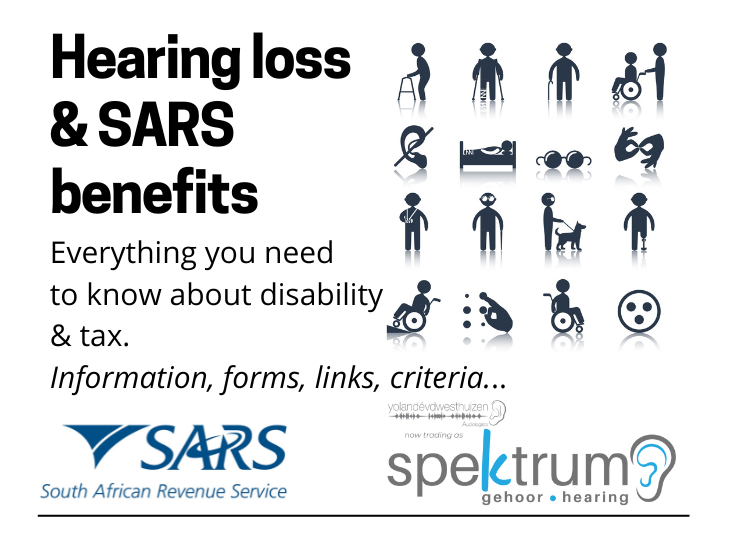Hearing impairment – SARS Additional Medical Expenses Tax Credit
The South African Revenue Service (SARS) makes provision for persons with disabilities in the form of an additional medical expenses tax credit. Disability in this context for tax purposes implies a moderate to severe limitation of any person’s ability to function or perform daily activities. This can be as a result of a physical, sensory (including hearing), communication, intellectual or mental impairment. The limitation (and the extent thereof) will only be regarded as a disability if it has lasted, or has a prognosis of lasting, more than a year and it has been diagnosed by a duly registered medical practitioner trained to diagnose the applicable disability or to express an opinion thereon.
Most individuals using hearing aids will qualify for this, even in some cases of only mild hearing loss. There are however cases where a hearing loss warrants the use of a hearing aid but do not necessarily fulfill in the minimum requirements as required by SARS. Limitations in hearing for tax purposes and are defined as follows:
Hearing disability is defined as the functional limitations resulting from a hearing impairment. Hearing impairment is a sensory impairment that will influence verbal communication between speaker and listener.
ADULTS: An adult is considered moderately to severely hearing impaired when the hearing loss is described as follows without the use of amplification:
- Bilateral hearing loss with a pure tone average equal to or greater than 25 dBHL in each ear.
- Unilateral hearing loss with pure tone average equal to or greater than 40 dBHL in the affected ear.
CHILDREN: A child is considered moderately – severely hearing impaired when the hearing loss is as follows without the use amplification:
- Bilateral hearing loss with a pure tone average greater than 15 dBHL in each ear.
- Unilateral hearing loss with a pure tone average equal to or greater than 20 dBHL in the affected ear.
- Hearing impairment is an abnormal or reduced function in hearing resulting from an auditory disorder.
- A child is a person between the ages of 0 to 18 years.
- Amplification devices include hearing aids, implantable devices and assistive listening devices.
- Pure Tone Average (PTA): average of hearing sensitivity thresholds (in decibel hearing level) to pure tone signals at 0.5kHz & 1kHz, 2kHz & 4kHz of each ear.
- Bilateral hearing loss is a hearing sensitivity loss in both ears.
- Unilateral hearing loss is a hearing sensitivity loss in one ear only
To find out whether you qualify for this contact us, we can complete these forms for you.
You can download the for here: ITR-DD-Confirmation-of-Diagnosis-of-Disability-External-Form – YVDW WEBSITE
Read more on this benefit on the SARS Website here.
HOW MUCH CAN YOU SAVE?
Use this handy calculator to find out how much you can save:
https://acgconsult.co.za/how-much-can-i-save%3F
Wierdapark – 012 653 3830
Saxby Medicross – 087 944 1803
Benoni – Northmead – 011 425 0171
Illovo – 011 268 0745
Bronkhorstspruit – 064 895 1565
